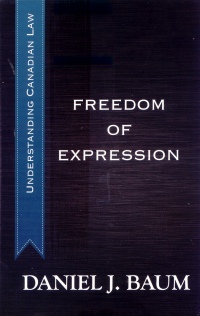| ________________
CM . . .
. Volume XXI Number 9 . . . . October 31, 2014
excerpt:
Freedom of Expression is the second volume in the series “Understanding Canadian Law”. Author Daniel J. Baum presents a number of legal cases in which individuals or groups act in ways which express deeply-held opinions, values, and beliefs, as well as the subsequent consequences of their having done so. The book’s format is similar to that of the previous volume in the series, Youth and the Law. Beginning with “Acknowledgements” of the role of the Supreme Court of Canada’s work, as well as the important role that the media has in disseminating the decisions of the Supreme Court, Baum provides an “Introduction” to the concept of freedom of expression. As the focus of the book is on how the Supreme Court of Canada decides cases which test an individual’s right to freedom of expression, the chapter entitled “Who Are the Judges?” describes the selection process for appointment to the Supreme Court, as well as a brief discussion of the potential roles of bias and emotion entering into a decision based on facts presented. The remainder of the book consists of five chapters, each of which presents a grouping of related cases, as well as the legal questions which these cases raise. Many of the cases explore subject matter which should engage young people: the right of a musician to post a video on YouTube, expressing his dismay at United Airline’s having damaged his guitar; the right of a public school student’s right to wear a kirpan (the symbolic dagger carried by Orthodox Sikhs), or the right of a public school teacher to express political and religious ideology in a classroom context (the Malcolm Ross case). The case of Ernst Zundel, the well-known Holocaust denier, is extensively discussed in the chapter on “Hate Crime”. And the final chapter focuses on “Indecency Defined” in which the focal case is that of a Montreal club which provided its fee-paying members the opportunity for participation in and/or observation of group sexual activity in a private area of the club, which members and guests entered through a controlled-access door. All of these cases offer thought-provoking explorations of the right to “freedom of expression”. However, the reader’s interest in these real-life cases is likely to wane as he or she reads through the judicial decisions rendered for the cases. For example, in 2001, the kirpan worn close to the body of an Orthodox Sikh student attending a Quebec public school accidentally dropped on the ground. Concern that this ceremonial dagger could be viewed as a weapon or dangerous object capable of harming others led the school board to prohibit the student’s wearing of the kirpan. As a result, the student (still a minor) and his father appealed the school board’s decision first to the lower courts of the province of Quebec and then, to the Supreme Court. After describing the case’s process up to Canada’s highest court, portions of the Supreme Court’s decision are quoted. In speaking of school policies designed to ensure safety, Justice Charron wrote:
Five more pages of similar content close off the description of the judicial decision-making process which concluded in affirming the student’s right to wear a kirpan in exercise of his freedom of religion. As in each chapter of Youth and the Law, Baum offers details of legal cases along with a series of questions about the particular cases under discussion, provides the reader with the opportunity to consider and rule upon a hypothetical case (“You Be the Judge”), poses “Challenge Questions” which further explore that chapter’s central issue, and ends each chapter with a listing of “References and Further Reading”, drawn from current media such as Globe & Mail, as well as academic and law journals, position papers and monographs. The book concludes with a thorough Index of the book’s contents. Adolescents are frequently quite vocal in their right to freely express themselves, and current social media technology offers them even more scope to do so. And, they may be very interested in the degree to which they can exercise those rights under Canada’s laws. However, as the opening pull quote and the quotation referencing the kirpan case indicate, Freedom of Expression is not an easy reference guide to those rights. As with Youth and the Law, the book’s highly academic content is challenging reading for students younger than the age of 17 or 18, and I think that even classroom teachers of high school Canadian Law classes would find this a less-than-accessible teaching resource. It is more suitable for students in post-secondary courses in sociology, criminology, and similar areas of study. While Freedom of Expression might be a possible acquisition for libraries in schools offering Canadian Law courses in grades 11 or 12, or as a supplemental resource for teachers of those courses, I can’t see its being used much by students. Recommended with Reservations. A retired teacher-librarian, Joanne Peters lives in Winnipeg, MB.
To comment on this title or this review, send mail to cm@umanitoba.ca.
Copyright © the Manitoba Library Association. Reproduction for personal use is permitted only if this copyright notice is maintained. Any
other reproduction is prohibited without permission.
CM Home | Next Review | Table of Contents for This Issue - October 31, 2014 | Back Issues | Search | CM Archive | Profiles Archive |
